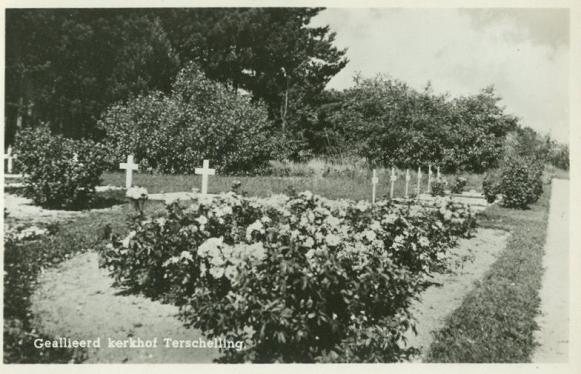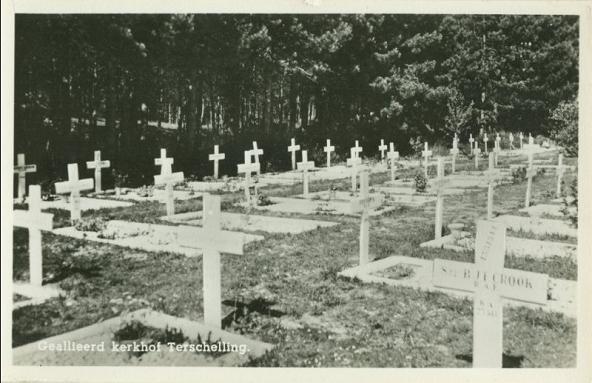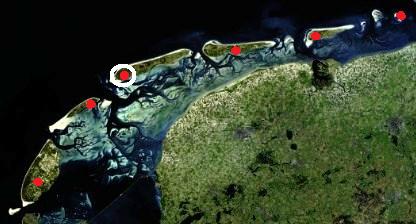
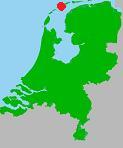
Relation with Lake (class): no. Cemetery without lake link.
Total nr. of casualties buried here (TC): 153 end WW2, today 84.
Lake casualties, initially, end WW2 (LC-I): 0
Unknown today: 17, all airmen.
of which unknown from Lake (LC-U): 0
of which unknown from North Sea (NS-U): 17
Initial burial site in WW2: yes.
Post war burial site for collection and reburial from other sites: no
Cemetery with Lake casualties today: no
TERSCHELLING BADWEG AND LONGWAY CEMETERY
Terschelling is the 3rd Frisian island. In the summer of 1940 the number of washed ashore French Dunkirk-victims was so high that the Germans ordered an emergency grave site in the dunes close to the beach at pole 8 at West aan Zee, Badweg (West upon sea). Here the graves had black crosses with only a number.
July/Augst 1942 a larger and more solemn new cemetery was constructed in the nearest village named West-Terschelling, along the Longway road. In Frisian dialect the words for lange weg (long road) is long way, as in English. The new Longway cemetery was used from August 29th 1942 and also the graves from the emergency dune Badweg site were relocated here. After the war almost half of the 150 graves in Longway were moved to other cemeteries on the mainland. Present today are 79 graves of Commonwealth casualties (62 identified and 17 non-identified) and 5 Polish airmen.
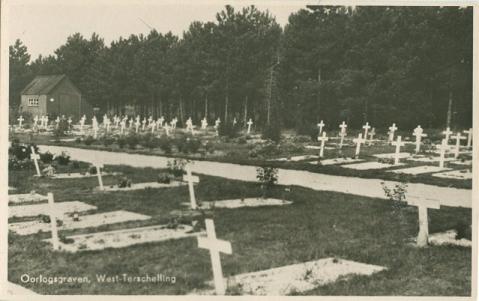
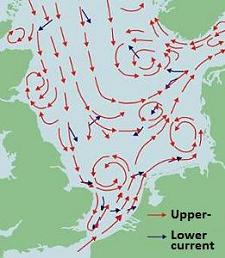
Dutch name cemetery: Dorp West-Terschelling, Alg. begr. pl aan de Longway.
Full name: Terschelling island, village West-Terschelling, war cemetery 'Longway'.
Address (usable for car navigation):
cars are not allowed on the island.
For reaction or comments; send us an email,
see address and info at CONTACT.
Please use as subject title: 'Terschelling'.
Badweg Cemetery
Below map shows the emergency Badweg cemetery location with the French graves at Pole 8, Badweg road, in the dunes close to the North Sea. It was closed in August 1942 and coffins were transferred to the new Longway-cemetery near the harbour. In Badweg the crosses were black (see below), in Longway white, see photo right-above.

Below photo. Badweg emergency cemetery at Pole 8, Badweg road. Grave no. 1 to 23 are the French casualties that washed ashore end July 1940 to 11 August 1940. Crosses no. 24, 25 and 26 have more black paint and are a bit newer. They are the first three British airmen washed ashore and buried on Terschelling, 17 August and 29 November 1940. This photo dates December 1940 - April 1941.
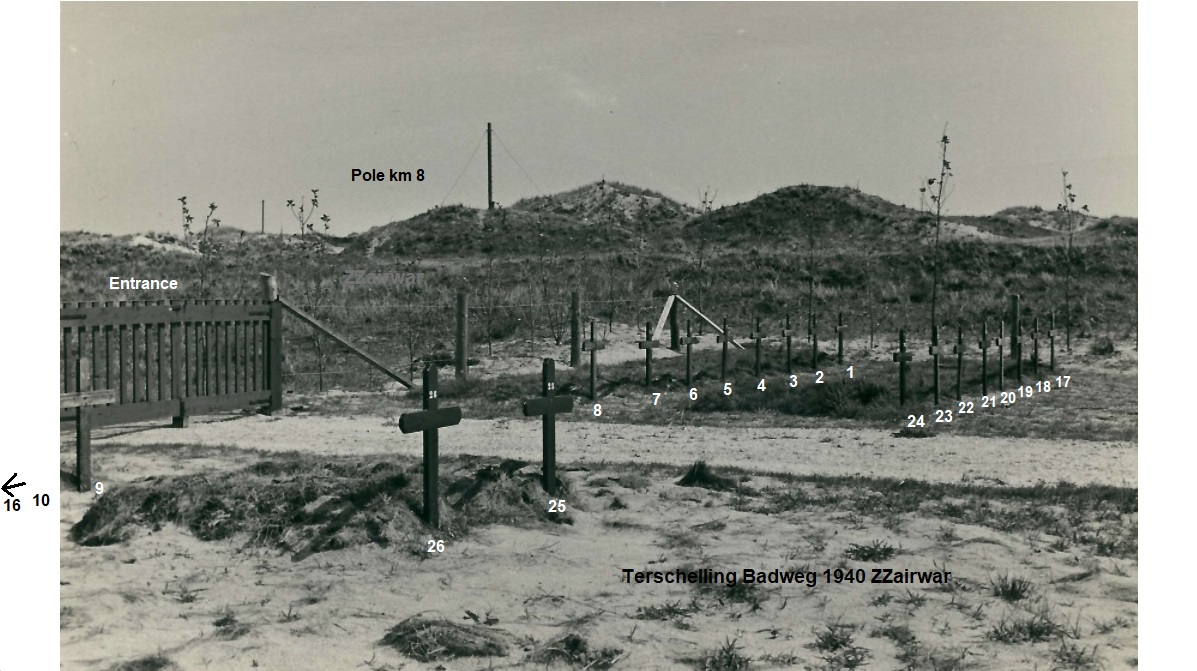
Another photo of Cemetery Badweg link: Bunkermuseum Terschelling. Shows a German soldier in work dress between grave 7 and 23.
The Emile Deschamps, 4 June 1940. Casualties (23) buried in Badweg.
After years of research we dare to state (26 December 2021) that all French washed ashore Dunkirk victims on Terschelling (and neighbouring Isles) are most from one ship, the Emile Deschamps. Packed with evacuees from Dunkirk harbour itself and the last ship to leave before the Germans entered the burning inner city. The ship struck a mine off Margate, only 10km from the British coast. This is in the Thames river entrance towards London. Below are their details. The men consists of the ship's crew and military passengers (evacuees).
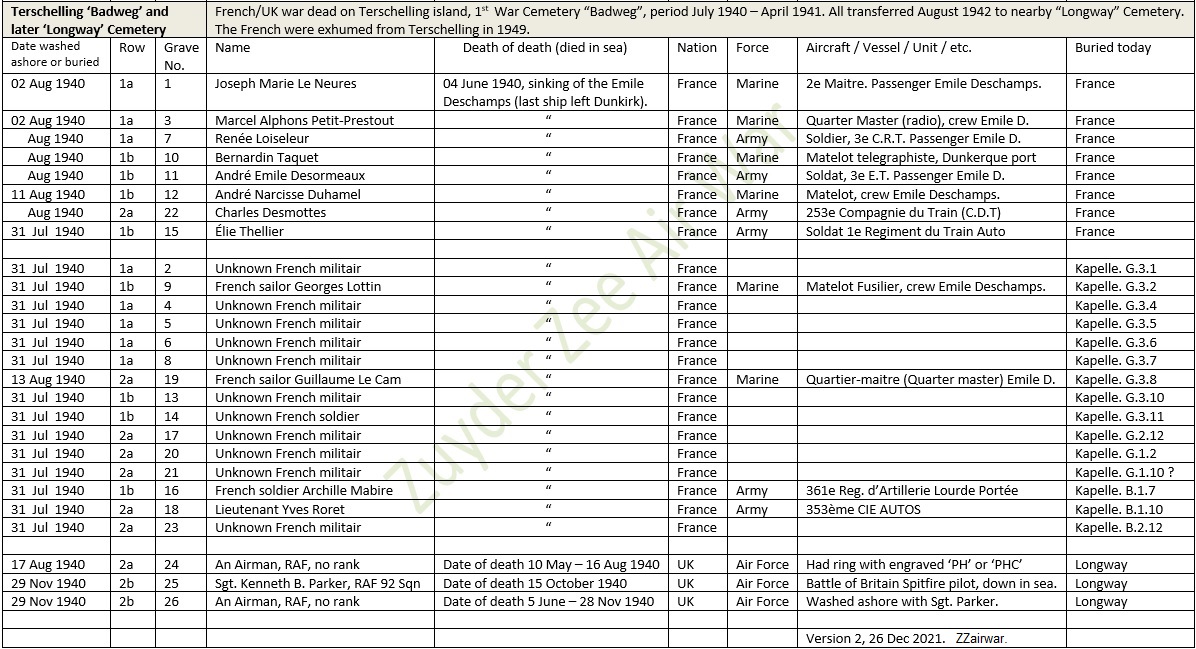
Grave 25
Cross 25 on above photo is the inital grave of Battle of Britian Spitfire (R6838, QJ-N) pilot Sgt. Kenneth B. Parker of 92 Squadron RAF, Biggin Hill. He was shot down in a dog-fight with Me-109 northeast of Maidstone, between Whitstable/Herne Bay and Margrate. This is the same location as where the Emile Deschamp sunk. Drowning there leads to washing ashore along the Northern Dutch Coast and Frisian Isles 6 to 9 weeks later.
-------------------------------------------------------
The Longway Cemetery
Mr. Henk van Kolck from Nijmegen was in 2004 as tourist on the island and decided to study the cemetery based on the original files. He wrote a book on it and later with help of his son Stef and grandson Sander they set up the 'Longway-Terschelling.nl' website to honor the soldiers that rest here. We recommend this website and have some things to add which can be read below.
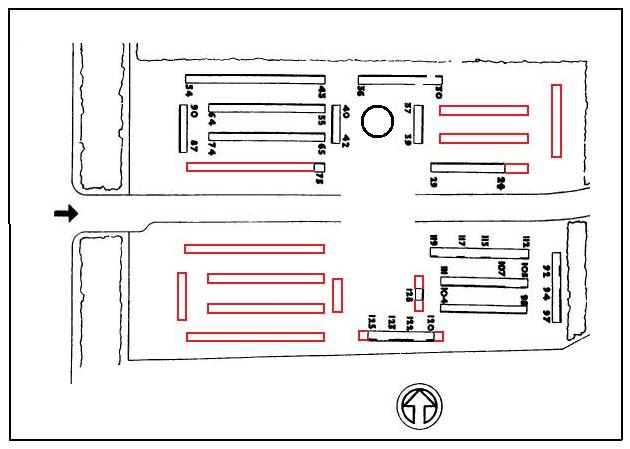
Longway War Cemetery. Exhumed grave positions in red
Outlined in red are the former grave positions on the cemetery. From here 19 American airmen were exhumed and taken to the the central US war cemeteries on the mainland. This was on the 25th of October 1945.
In the summer of 1949 also the French government removed their war dead, 23 soldiers in total. 1 Norwegian pilot was brought back to Norway.
Read more on the Americans, French and the Norwegian pilot below.
Finally in the 1950's some 24 Germans went to the central German war cemetery in the Netherlands 'Ysselsteyn'.
Not all graves in the red rows were occupied. The rows in black are the grave positions today.
Arial photo of Longway Cemetery present day.
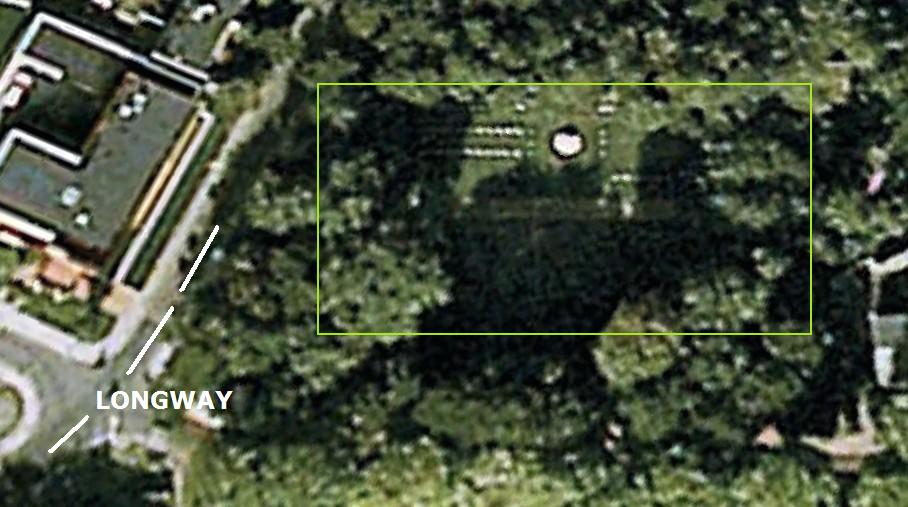
Photos and info of the Longway Cemetery today. CWGC website: https://www.cwgc.org/visit-us/find-cemeteries-memorials/cemetery-details/2062403
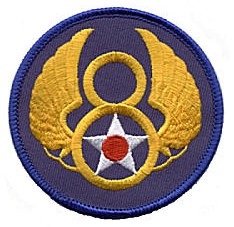 The Americans
The Americans
Most of the 19 US-airmen here were killed in the early raids on the North-German ports in 1943 and later washed ashore on this island. Because of the crashes in sea, these crews suffered many men MIA, not all were found.
There is a small link with the airwar over Lake IJsselmeer (the subject of this site). That is that on 27 January 1943 a flight of the 44 BG tried to bomb as alternative target for Wilhemshaven the Dutch Old Zuyder Sea harbor town Lemmer. This showed their inexperience; holding a Dutch inland village 60 miles from the German border for a North German naval base. Fact is that Lemmer is regarded by more people as a German port, especially in summer, but to bomb it with B-24 is a bit too much. The bombs fell in the fields behind Lemmer. After the pass over Lemmer turning north-north-west into the direction of the Frisians, the B-24's were jumped by German fighters and two 44 BG B-24 crashed in the Wadden Sea under Terschelling island. This involved the 41-23776 and the 41-23690.
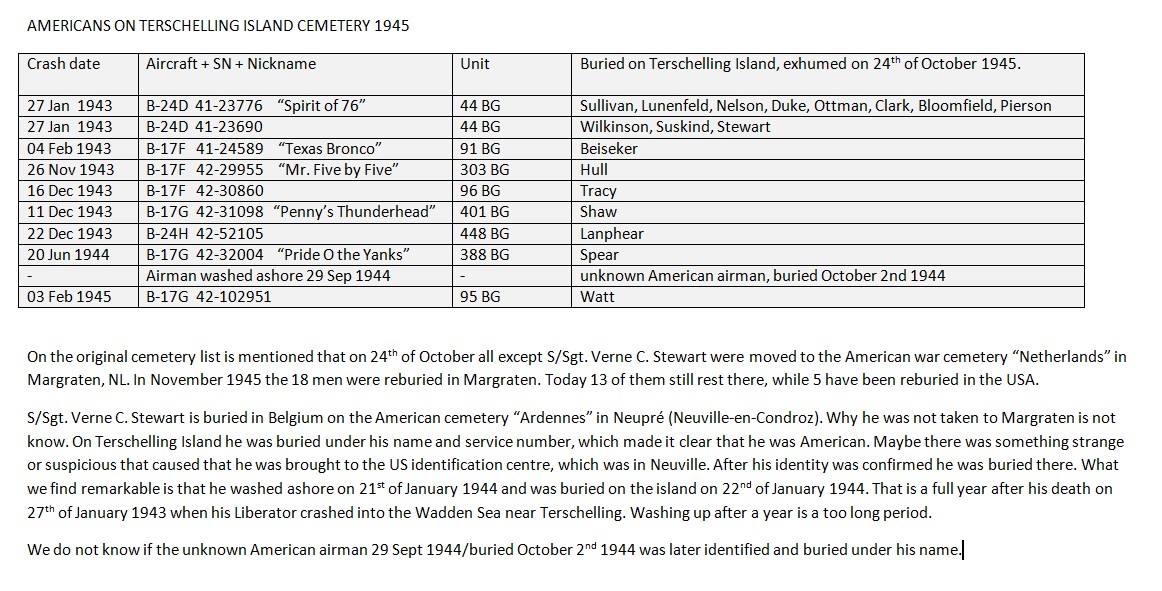
Post scriptum December 2021: It is almost certain the un-identified American airman 29 Sept 1944 was not identified later, he remained unknown. I fact, not 19 Americans were exhumed from Terschelling, but 21. Two other non-identified American airmen were found between the year 1943 British dead but were never identified and rest as Known unto God in US 'Ardennes' Cemetery in Belgium.
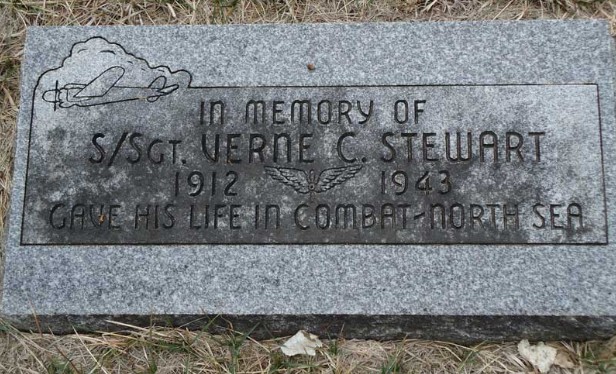
Memorial stone for S/Sgt. Verne C. Stewart.
Hillside Cemetery, North Loup, Valley County, Nebraska, USA.
Sgt. Stewart was crew of B-24 41-23690, 44 BG (Wilhelmshaven/Lemmer raid on 27 Jan 1943). He was buried a year after his crash in sea. An explanation for this late interment could be that the Germans recovered the wreck from the Wadden Sea and found the remains of Sgt. Stewart inside.
Sgt. Stewart is now buried on US war cemetery "Ardennes" in Belgium.
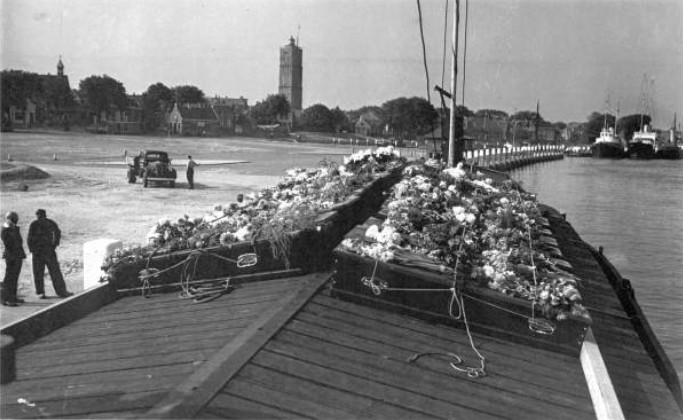
Terschelling harbor, October 24, 1945.
Often published newspaper photo of the 19 exhumed American airmen leaving Terschelling harbor destination US war cemetery "Netherlands" in Margraten. Coffins are placed on a barge. Locals covered them with flowers. In the background the Brandaris lighthouse tower.
The French
On Terschelling island on Longway cemetery lay 23 French soldiers. Most of them washed ashore here in August 1940. They were killed during the evacuation of Dunkirk (Dunkerque), which took place between May 26 and June 4rd, 1940. On Terschelling the French are from ship Emile Deschamps.
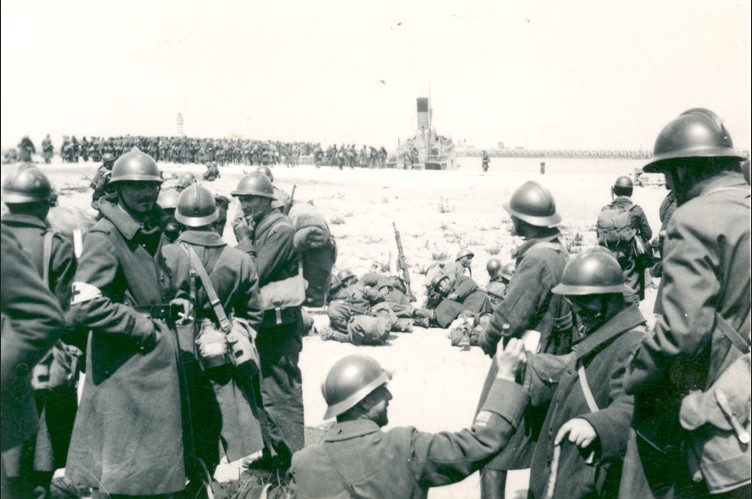
Dunkirk - Dunkerque
French militaires on the beach of Dunkirk, June 1st, 1940. They wait their turn to be shipped-in and make the escape to England. Anti-aircraft shells explode in the air trying to keep-off attacking German aircraft. This group has their light machineguns at the ready pointing at the sky. Dozens of ships were hit and sunk. Bodies of more than 200 French soldiers were taken north by the North Sea current and washed ashore on Dutch beaches end of July and August 1940. Half of them could not be identified.
French reburials 1949. Terschelling to Kapelle
The site 'Longway-Terschelling' shows a list with names of the 23 French soldiers on Terschelling and mentions they were brought back to France after the war. This is not entirely correct. In 1949 the French government decided to collect all their war dead in The Netherlands and re-bury them in Kapelle, which was designated to become the central French war cemetery in the Netherlands, 25 km north-west of Antwerp. Family could also choose for reburial in the hometown in France itself and therefore a part of the victims were repatriated to France, see below list.
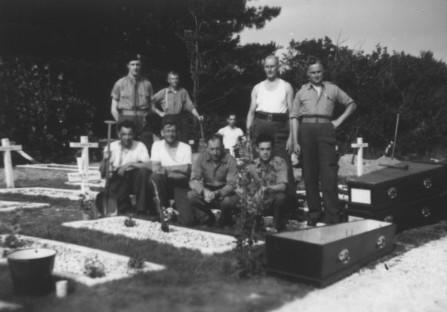
Grave recovery team, 25th August 1949
This picture is dated 25th of August 1949 on Terschelling. What we see here is an army grave recovery and identification team exhuming the French war dead. Nine men are on this photo and according to a newpaper article they are a Dutch army team under command of Captain Kleinbussink. They have new coffins on the right. On the front of each offin a white label is attached with information on the remains inside. A hammer lays on the lid of the top coffin.
On the island was also French officer captain des Loges as representative of the French government. Possible he also had some men with him and was the recovery team mixed Dutch-French. For better pictures see site Longway-Terschelling.nl/kerkhof.html.
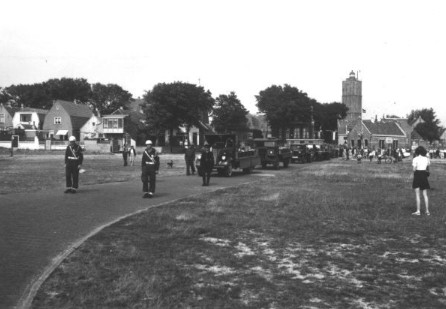
Transport to the ferry boat, 1st September 1949
Prior to the transport the coffins with exhumed French war dead were placed in a school (de former machinistenschool) which was decorated with flags as 'chapelle ardente'. With full ceremony and respect the trucks that carry the coffins drive up to the boat. Up front are two Dutch military policemen. This was on the 1st of September 1949.
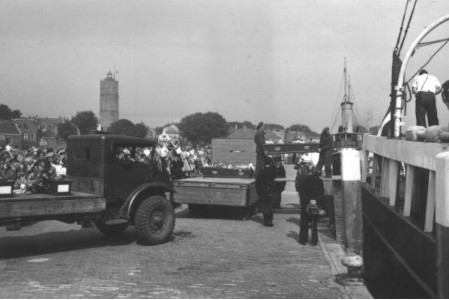
Loading the coffins with French war dead on board
Two soldiers with typical berets (French?) carry a coffin in between them and carefully walk the plank to load the coffin onboard. Two Dutch policemen (in black uniform) are standing at the attention on each side of the plank. A man in black suit (the undertaker?) holds his hat behind his back.
Cameraman
On the boat's upper deck a men in the white shirt is a cameraman and he is filming for the French movie news. Notice the white labels again on coffins-fronts on the truck left.
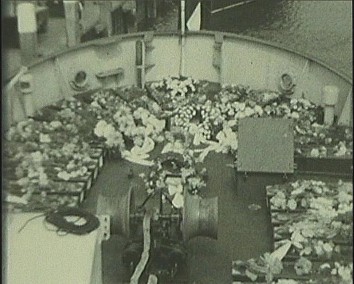
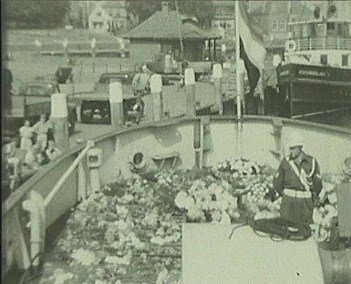
The work of the French cameraman
Just as with the exhumed American airmen 4 years earlier in 1945, the coffins of the French are also fully covered with flowers by the local population.
On the picture on the right, the white labels on the front of the coffins are visible again. For better photo's see site Longway-Terschelling.nl/fransen.html
The French (above images).
The French text with the above scenes was: "le 1-er Septembre 1949 on tranféré les restes de ces militaires de l'ile de Terschelling á Harlingen, afin de pouvoir les transporter á leur patrie". In English: on the 1st of September 1949 the remains of these soldiers were transferred from the island of Terschelling to Harlingen for further transport to their homeland.
ZZairwar: of these 23 French soldiers only 12 were identified. Eight of them were actually reburied in France. The other men (11 non-identified) were re-interred in Kapelle (NL). The 5 men with a name were: Yves Roret, Georges Lottin, Achille Mabire and Guillaume Lecam, see underneath photo's.
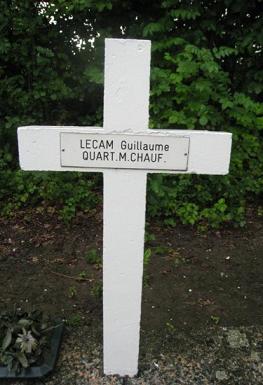
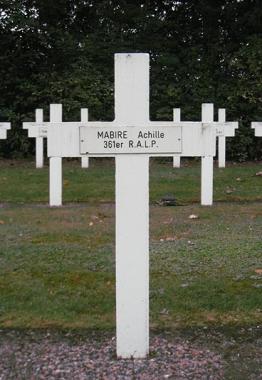
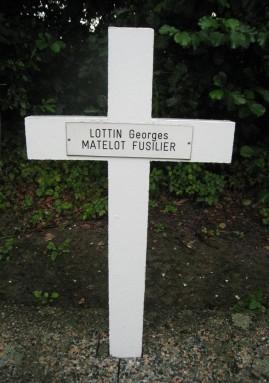
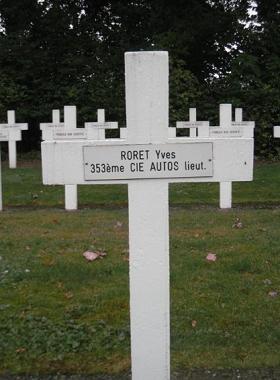
.
The Norwegian pilot
On the 3rd of October 1943 a Halifax bomber of RAF 76 Sqn crashed in the Wadden near Terschelling. 2 men of the crew were Norwegian as well was the pilot Lt. Nils Eckhoff. He was killed and found next morning with his parachute on the island. Together with RAF F/O Sheerman both were buried next to each other on Longway. On request of his family, the remains of Lt. Eckhoff went after the war to Driehuis-Westerveld (the crematorium with the bad war reputation, see page Driehuis-Westerveld), he was cremated on 22nd of May 1946. On the 12th of September of that year his ashes was added to the Eckhoff family grave on the Vestre Gravlund Cemetery in Oslo, Norway.
Sgt. S. Meieran RNAF and Sgt. J. Skelanger of the RNAF became POW, also RAF Sgt. Coster and Sgt. R. Coup. One man was seriously injured and brought to a hospital on the mainland. This was Sgt. A. Hayes. He died a few days later and is buried in Leeuwarden.
The Polish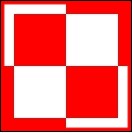
All 5 washed ashore here. There are no unidentified Polish airmen on Terschelling.
Grave 58. Kpt. Eugeniusz Marian Lech (300 Sqn, Wellington Z1215, 20 June 1942). Washed ashore 14 July 1942.
Grave 59. Por. Pil. Zbigniew Jan Kazimierz Dubas (301 Sqn, Wellington Z1345, 23 June 1942). Washed ashore 15 July 1942.
Grave 62. Pplk (Group Captain) Jakub Stanislaw Skarzynski (305 Sqn, Wellington Z8528, 26 June 1942). Washed ashore 21 July 1942.
Grave 98. Kpt. Jan Polnik (138 Sqn, SOE, Halifax DT627, 12 May 1943). Washed ashore 30 June 1943.
Grave 99. St. Sierz Bronislaw Wojno (DT627), 12 May 1943. Washed ashore 1 July 1943.
For the full story of those men please see site: Polish War Graves.nl/ned/west.htm
The Unknown
Of the men that the North Sea brought in, 17 remained unknown, also after attempts to identify them after the war. What is unusual is that all 17 are airmen, no sailors or soldiers. 16 of the unknown are RAF and 11 of them are most sergeants washed ashore from April until October 1942. Their crash date and date of death can lay up to 7 months further back than the date on their stone. Only one unknown Sgt. is Australian. For an overview of these men and their headstones see the site 'Longway-Terschelling.nl', menu-item (on the left) 'De onbekenden'. The 62 identified commenwealth servicemen can be found at 'De graven'.
© ZZairwar (Zuyder Zee Air War)
